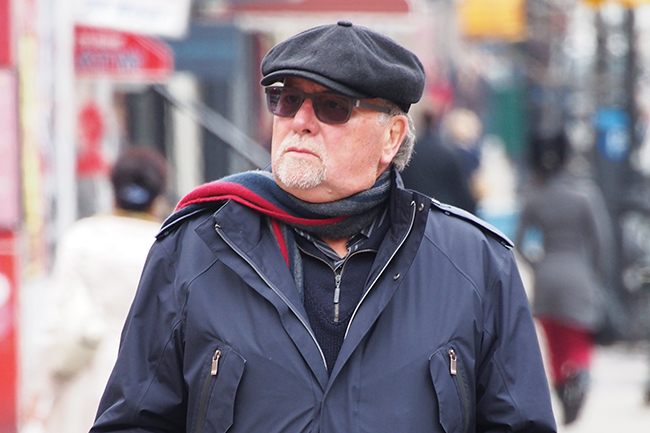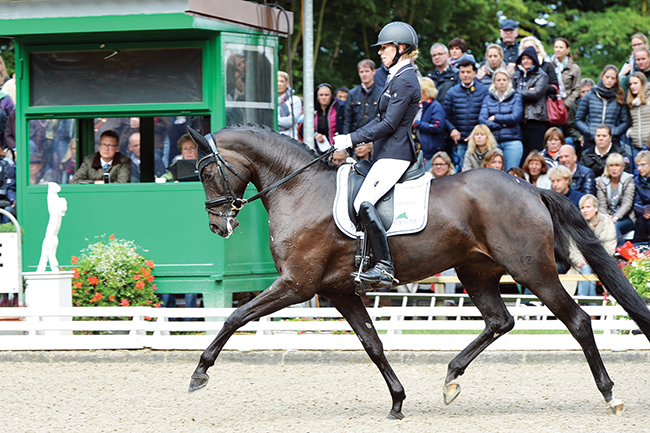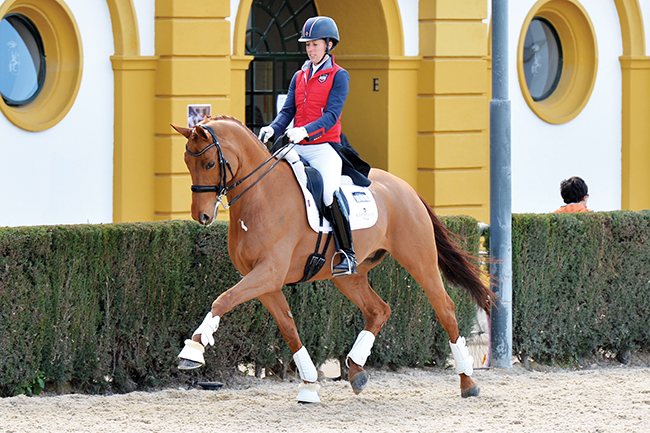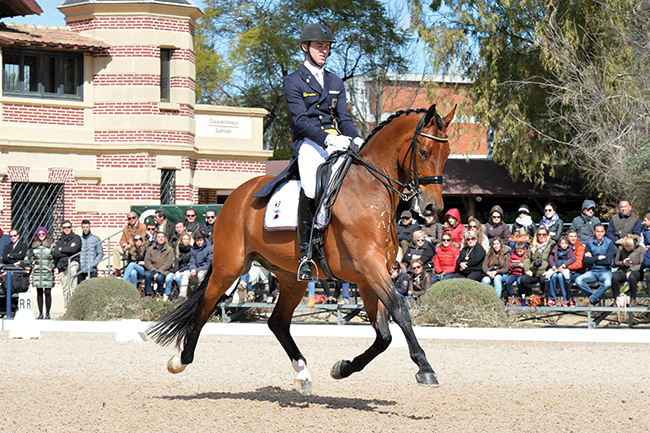
Story by Christopher Hector
Recently British dressage identity David Pincus raised the issue of the direction of dressage breeding in the pages of Britain’s Horse & Hound – full text: http://www.horseandhound.co.uk/exclusive/david-pincus-breeding-a-hypothetical-type-is-ruining-dressage-hh-vip-527032.
He, like a number of commentators, suggested that the various breed societies had lost their way and that despite years of selective breeding, finding a top horse, particularly one with piaffe, was difficult to find. He suggested that the fanfare around the stallion licensings and young horse classes, has resulted in stallions that only produce young horse stars, being popular with the breeders…
“Today, three-year-old stallions have to create an optical illusion of balance, energy and power, despite only trotting in-hand.”
Pinkus suggests: “The other cause for concern is the breed societies’ insistence on directing towards a hypothetical type. They ignore the fact that Valegro, the world’s best dressage horse – nearly perfect in physical ability – is a completely different type, one that would be rejected in stallion selection. Give me a good cob any day; at least he’ll hack if he fails in dressage.”

Essence of Young Horse breeding – but will she go FEI? Isabell Bache and Fasine
Let’s look at the world’s best dressage horses and see how the theory fits. Now I think the problem has been compounded by some of the statistical ‘aids’ to breeders set into place by the breed societies, and the national federations – like the German FN breeding values, which tend to favor young stallions with no Grand Prix progeny, over stallions with proven Grand Prix performers. Thus we have Fürstenball and Lissaro in first and second place on the FN standings – both of them young horse class stars – while stallions like De Niro or Breitling with a host of progeny doing Grand Prix, don’t make the topliste.
Another problem is that there are any number of ‘rankings’ of dressage competitors, but most of them are just testimony to how far (and how often) some riders are prepared to travel in search of a ribbon. This means that horses like Valegro, or Charlotte’s new star (three Grand Prix, all over 70%) Barolo, don’t get a mention, while some seriously indifferent performers hog the limelight.
Let’s start our examination with Charlotte’s two. Valegro, as David has noted, is hardly the modern type, indeed he, like so many other stars, was rejected at the KWPN licensing. His sire, Negro, is again, a short legged, stocky chap, and while he is by a dressage star, Ferro, it might be remembered that Ferro started life as a showjumper, and Ferro’s dam sire is the very substantial Holsteiner, Farn. Negro’s dam sire is Variant, another slightly old fashioned type, by the Thoroughbred, Afrikaner, and out of a jumping mare, and grand-daughter of another substantial Holsteiner import to Holland, Amor. Valegro’s dam has a pedigree that screams JUMP. His dam is by Gershwin, a 1.50 showjumping son of Voltaire, out of a mare by Nimmerdor, with more Holsteiner jumping blood on the bottom line.
The chestnut Hanoverian gelding, Barolo looks more like the modern dressage type – which is lucky since his dad, Breitling, had the reputation of producing prodigiously talented Grand Prix horses that were perhaps a little plain and old fashioned looking, like the stallion. But if Barolo’s sire fits my theory that dressage breeders have been concentrating too much on the refined dressage type, his dam side breeding would seem to shoot the theory down in flames, since Barolo is really concentrated dressage breeding on the dam line. 
Charlotte Dujardin and Barolo
Barolo’s dam, Highlight, is by Hitchcock, by the Irish Thoroughbred, Hill Hawk who appears on a number of dressage pedigrees, and is the dam sire of all the Welt Hits. Hitchcock’s grand-dam, Baronesse (by the Thoroughbred, Bleep) is the dam of one of the early influential dressage sires in the Hanoverian book – Bolero. Highlight is out of a mare by Wenzel, another of the Hanoverian dressage pioneers, out of a mare by Shogun, more Thoroughbred blood. Okay, I wasn’t saying that it is impossible to produce dressage stars with dressage breeding, just that in many, if not most of the cases, strong jumping blood plays a rôle.
Let’s quickly look at another emerging star on the dressage scene, Cosmo, because that fits my thesis perfectly. Twenty-one year old Sönke Rothenberger and nine-year old Cosmo are rapidly emerging as very strong contenders for a place in the German dressage team to go to Rio later this year, kicking off the season with a win in the Grand Prix at Jerez, beating British team gold medallists, Carl Hester and Nip Tuck in the process.
Cosmo is by the current super star of world showjumping, Van Gogh, who has just picked up a €250,000 bonus for winning both the Grand Prix of Los Angeles and Hong Kong, and then reaped in lots more cash with a win in Shanghai, with Marco Kutscher in the saddle. Van Gogh is pure jumping bred, by Numero Uno out of a grand-daughter of Ramiro out of a daughter of Burrgraaf. Cosmo’s dam is similarly jumping bred, by the Landadel son, Landjonker (Frühling in Holland), although we do remember that Landadel was the sire of Leonardo da Vinci, who Sönke’s mum, Gonnelien, rode very successfully in international dressage competition. There’s more jumping blood on the bottom line with Farn and Amor, although the grand-dam is by Aktion who was an international dressage competitor – who looked like a Holstein jumper – with Hungarian, Gyula Dallos.
Sönke Rothenberger and Cosmo
Indeed it is precisely this jumping breeding that appealed to Sönke’s father, former international dressage star, Sven Rothenberger, although he points out that Van Gogh has shown dressage quality as well:
“He had for more than eight years the highest mark in dressage in the stallion test. It was not a surprise that he could breed dressage horses, there are some really good dressage horses in Holland by Van Gogh. We knew there was something special in him, not only as a jumper, it is more the old Holstein breeding that comes a little bit through. This makes special horses, not normal horses, they have big movements, a lot of elasticity and they feel happy with their bodies, they use all their muscles – this is jumping, good jumping, that the horse is loose in itself, not stiff. They have strength to carry weight, but also big gaits, they have a really good canter, that’s what I really love.”
A quick look at the pedigree of some of the other stars of dressage in recent years, points again to horses that come from outside of the dressage ‘box’. Salinero was bred to jump, and indeed his brother showjumped at the Olympic Games. Totilas was by the Grand Prix dressage stallion, Gribaldi, but his dam was solidly jumping bred: Nimmerdor, Marco Polo, Amor.
The world current number one, Desperados, is obviously the product of specialist dressage breeding. He is by the great De Niro, out of a Wolkenstein II mare, with the slightly left of centre addition of the French Anglo Arab, Matcho, to give him that wonderful black skin. But – and only future years will bear this out – my feeling is that if he produces dressage stars in the future, they will be out of solidly athletic mares with a good dash of jumping blood.
Similarly, the current top horse in the Dutch ranks, Voice, is solidly dressage bred, by De Niro out of a Rohdiamant mare, out of a mare by one of the first Dutch dressage sire stars, the Trakehner, Doruto – with just a dash of Amor on the bottom line.
I am reminded on Dorothy Parker’s jibe at Alexander Wallcott – it doesn’t take courage to sit on the fence, just a bloody fat arse – but am forced to say while I agree with David Pincus that most of the licensing stallion stars, and young horse stars will never go into Grand Prix ranks, an examination of the current crop of top horses shows that some are purely dressage bred… and some are not.

I think the problem is more to do with breeding the young horse star rather than specific dressage breeding, or rather the dressage breeders have lost sight of what is required for a good dressage horse. The conformation and gaits required for a dressage horse and a jumper have always been very similar. Like you mentioned the old school thought was always for a quality horse. The dressage lines could jump but seemed to have more aptitude in general for dressage and visa versa. The mistake has been breeding for the extravagant trot, and a horse that looks like it is in an uphill balance at 3 years or younger. Because of their natural abilities these young horses are often persieved as being able to do quality GP ata younger age. Therefore they are often not trained with the time and care that every horse requires so they often end up lame and unless before reaching the upper levels of dressage. More important is the focus in breeding the extravagant leggy trot. It is difficult to collect yes, but good dressage riders know it is a quality canter (and walk) that is required if you wish to reach the upper levels. This is something the jumpers have not forgotten as most of their work also requires a quality canter. There is a lot a rider can do to improve a trot, but it is mandatory to start with a quality canter and walk if you wish to do well and be competitive at GP.
Thank you for posting this. Very interesting comments on the older bloodlines and older types. Some of our best all around horses had Trakehner blood crossed with Hanoverian or Dutch. Some of the more solid Arabian stallions also have a great deal to offer in movement, especially elasticity, soundness, good feet, short cannon bones, and hocks well let down with good angles. Sometimes good breeders have to follow their gut and what they believe in, and not necessarily the current fads.
It is excellent that people like David Pinkus call attention to the problem, but it is a lot worse than described in the above article. In my article “Happy athlete or deplorable creature” I am describing the various alterations the modern dressage horse has suffered especially over the last two decades.
It was written for horsezone.co.uk as a response to some critique in horse & hound about English horse breeding concluding in the request to follow the lead of the Dutch and German breeders.
Agree wholeheartedly with the article. The problem is that breeders breed for sale and if the buyers are pixillated with leggy, huge trots withot looking at stability of paces and a great canter then what can we do – go on breeding good quality movers with solid foundations that non one wants to but or go for the sale with horses that will, in the long term, be unsuitable.
A top dressage and showjumper must be able both do two things at the top…sit and push…so this makes complete sense that dressage horse is from jumping blood does it not?
Has anyone ever done any research as to how , not only the young horse winners but also the top futurity winners over the past 5-10 yrs have progressed as they have got older , a sort of , where are they now ?sucess wise.
For us breeders the main target should be to produce reliable horses with impeccable characters and good gaits, specially walk and canter.
Horses that children and young riders can handle. Everything else will work out – either in dressage or jumping – when after careful preparation
our “products” start their respective careers with the right person under the saddle
In 25 years of breeding German Sports Horses in Italy I learnt that as in human families there might be resemblances, short-comings or special talents with the same parents, but real life depends on so many “imprinting” factors like surroundings and education.
VALEGRO was meant to find CARL HESTER and CHARLOTTE DUJARDIN who made him an outstanding horse, WEIHEGOLD was lucky to find ISABEL WERTH… All these riders with dedication and professional work made them what they are now, there is no recipe to breed a “crack”. The only orientation aid may be to look for sires and dams with established progeny like RUBINSTEIN I, DONNERHALL, DE NIRO and not to run after “modern” 3-year-olds with stunning trots.
Extravagant trots have been around since at least the early eighties.
The very BEST I have read for a very long time! Spot on!!
The question is?? When will it stop??
Will it come to the same as the German Shepherds, dogs that can hardly stand on their hind legs.
Thank you very much for sharing this article!
Silva Olsson-Ellis
It’s not just the breeding its more about the forcefull training methods used. Unless the training is corrected breeding isn’t the main issue. As classical dressage in lightness brings out the best in the horse. Force methods you see alot today will ruin a well breed horse.
I’d be more inclined to look at the producer rather than the breeding. You can look at all the equestrian disciplines and find producers who produce horses with unfashionable lines because they start off with no money and because of their success then get sent horses with fashionable lines, and of course, on the whole, make superstars of them as well.
The major problem is that young horses has to perform too quickly. They must give a big show with the front leg. A lot of the young horses who performs very well at young ages you don’t hear anything anymore about them because they are ridden too long. At higher age collection will be the problem.
Oh yes couldn’t agree more. Whats happening to horse breeding these days! We are getting ever more and more extreme movement weak hind ends and neurotic characters. I think a lot of the blame can be found in young dressage horse competitions, arguably the auction yard of young stock. So a horse must look like a grand prix star even though it doesn’t have the fundaments to ever become one. The important thing is that they sell, they sell like hot cakes and for a lot of money. Feeble wobbly piaffes and dragging hind ends with flashy fronts are the modern dressage horse du jour. While the solid performers and greatest stars that perhaps dressage has ever known Valegro and Verdades are exactly the opposite. Balanced yes, both in build and type with strong hind ends and true athleticism to do any amount of extending and collection, piaffe machines. Jumping plus old Groninger plus hackney going on……
The Groningen is extinct as a result of a misguided Dutch breeding policy to modernise at all costs, Also a mistake IMO to seperate breeding into jumping and dressage. And believe me when I say it as i’ve seen plenty in my time the Groninger was a remarkable big heavy horse you could sit on bareback in a field, no bridle and it would look after you. Grounded biddable and powerful. Many a time an old farmer dressed in his finest would proudly show me his Groningen mares. All gone. The modern invention is nothing whats so ever like the original in any shape or form. I think breeding has gone astray these massively powerful horses plus a dash of high blood be it in hackney or full blood is what makes a good dressage horse. Not line bred inbreds dressage after dressage that are flashy youngsters these are just auction fodder that sells.
One the one hand you have a product that sells but on the other you have a product that rarely performs to the top of the sport…….I know where riders with any sense would be looking, not at young horse competitions but in Holstein and Hannover where they meet.
You also need to consider why a dressage horse stays sound and enjoys his much earned retirement. The majority of Carl Hester’s GP horses stay sound, why? Because they are produced patiently at their own pace. I remember watching a demo where Carl was training Velgro aged 6, he said that he could be greedy with Velegro because of his obvious talent however he choose to produce him at a slower pace because he wanted him to go all the way and ultimately he cared about his well being. Blueberry may be an older fashioned shorter legged type but has been produced to perfection and just look at the outcome. How we produce horses is so so important-even more so if there are imperfections in their confirmation. I worry about the ‘flashy leggy’ dressage youngsters that at the ages of 3 are over produced without the longer term welfare being considered. Although I understand people make a living from horses, ultimately the welfare of horses should be paramount.
You also need to consider why a dressage horse stays sound and enjoys his much earned retirement. The majority of Carl Hester’s GP horses stay sound, why? Because they are produced patiently at their own pace. I remember watching a demo where Carl was training Velgro aged 6, he said that he could be greedy with Velegro because of his obvious talent however he choose to produce him at a slower pace because he wanted him to go all the way and ultimately he cared about his well being. Blueberry may be an older fashioned shorter legged type but has been produced to perfection and just look at the outcome. How we produce horses is so so important-even more so if there are imperfections in their confirmation. I worry about the ‘flashy leggy’ dressage youngsters that at the ages of 3 are over produced without the longer term welfare being considered. Although I understand people make a living from horses, ultimately the welfare of horses should be paramount.
We also have the wonderful stallion Quaterback, but the sons of his that I see are out of very light, modern bloodlines, and don’t have what he has. Cross him back to something with substance to get a GP horse.
I saw someone above mention the use of arabs in the breeding of wb. I agree with this. The thoroughbred influence makes the horses look thoughroughbred. Too light. Too long legged. Then u have something I’m seeing more and more of. Sickle hocked youngsters! Sickle hocked breeding stock wining their inspections and at shows and they r not under themsekeves because of training. They r under the sleeves becouse of sickle hocks. Back to. Arabs. Many of the old style thick boned arabs with normal heads r gone. However, there r some that remain. Like my mare through he full malabar bred dam. I crossed her with a wb and may not get hight, but I have gotten that thick bone and a web moving horse with the addition of my mares canter, it was her best gait. You wouldn’t even know he had arab in him if I didn’t give u his mares line. Yet, despite arab being a foundation breed they r looked down on as crosses for full wb breeding programs. It’s a shame. They add so much when crossed right. Isabella weg winning mare this year had arab in her as I understand it. Then some say we want it 2 or 3 Gen back if at all. Where how do u get it to start? And why do so often Arabian mares or stallion shave to work harder to be accepted as breeding stock when ur seeing full wb horses all sickle hocked and breaking down passing with flying colors? Something has gone seriously wrong. I will say as much as Oldenburg na is looked down on, I like it that they r more open to arabs because they have a lot more to offer than the other registries seem to give them credit for.